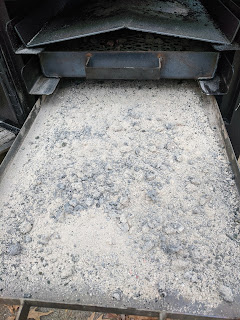The Kroger test was run on a warm afternoon and the ash pan picture was not taken at the right time, the charcoal hadn't had time to burn out completely. So I decided to retest under similar conditions to Royal Oak Natural. This lead to refining my conclusions a little as well. Ash pan the morning after:
35 minutes to reach 200 degrees.
Peak temperature 354 degree.
200 to 200 degrees burn time 151 degrees.
Updated conclusions:
Firstly, the Kroger got hotter this time than it did when it was warm, this speaks well of my Assassin grill's build and insulation. Secondly, the discrepancies between the 2 Kroger burns shines a light on the simple fact that in a outdoor grilling environment the discrepancies in the shape of the charcoal mound, how the lighter gets on with it's job, and other factors make more difference than the charcoal itself. If we were to conclude that all the briquets performed equally that would give the win to Royal, because in this area all are sold at approximately 50 cents per lb, and the Royal is 77% as dense as Kroger, and 91% as dense as Kingsford. So, it burned equally hot with less weight since the test was done by volume. (More literal bang for your literal buck.) Ultimately, the main reason to select a given briquet over another is preference, and I prefer Royal because of how close to natural lump it is. The other 2 have various different proprietary ingredients. On a side note, Charblox burned as advertised but didn't get hot enough to justify the cost. If they revisit their pricing to be competitive with briquets, I would probably keep them on hand for long cooks.




